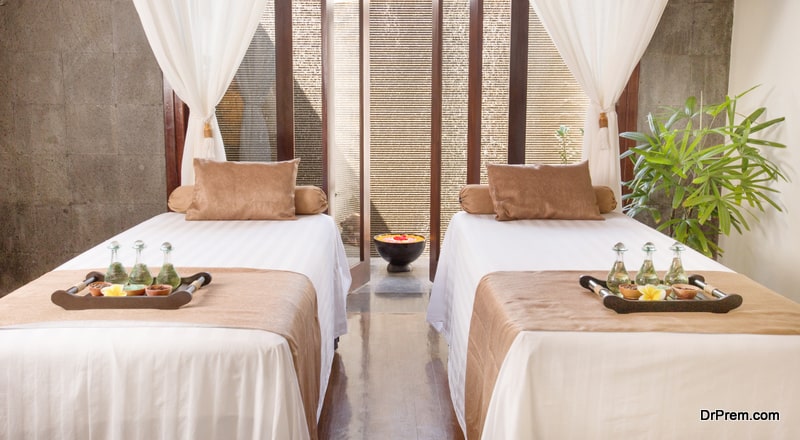Integrated wellness practices are likely to be a permanent feature in the global healthcare and medical tourism industry. So if you find your physician prescribing breathing exercises, yoga, Tai Chi or other unconventional treatments along with medications, do not get surprised. The practice is evolving and is yet to get into the mainstream. Healthcare providers have acknowledged health and wellness are inseparable and a holistic personalized approach to treatment is the only way to proper healing.
The overall perception of healthcare and wellness is changing. People are looking for balanced wellness practices in the clinical setting with proven outcomes. The massive socio-economic damage inflicted by the pandemic and the growing awareness of self wellbeing has pushed forward the need for this integration.
The global disease burden has become unmanageable
Research by World Economic Forum released a few years before revealed chronic ailments kill over 36 million people every year and are projected to kill tens of millions more in the near future. The global economic impact of chronic diseases led by cancer, diabetes, mental ailments, heart diseases and respiratory diseases could touch $47 billion by 2030.
Wrong approach leading to health disasters
Since long, we have got used to quick-fixing our health and wellness issues through reactive medicine for quick respite from the problems. This long-built practice has impacted the basics of healthcare and failed to address the root concern. Global healthcare has reached a stage where reactive medicine is not helping in reducing the mortality rates or the incidences of disease. There is a dire need to change our approach to healthcare emphasizing preventative wellness practices for the prevention of diseases and better health management at a reduced cost enabling an enhanced quality of life.
Integrative wellness practices are cost-effective and prevent big-ticket chronic diseases
Integrated wellness practices focus on vitality and wellness rather than the disease and its symptoms. Evidence-based wellness practices like mindfulness, meditation, yoga, acupuncture, chiropractic, sound healing, music therapy, TCM etc. are finding more applications in conventional treatment modalities based on the patient’s health status and lifestyle.
Seven preventable chronic diseases like cancer, diabetes, hypertension, stroke, heart disease, pulmonary ailments and mental illness cost the US economy $3.1 trillion annually. Research has demonstrated the cost-benefit of naturopathic medicine in preventing cardiovascular disease and metabolic syndrome.
A 2002 study on Diabetes Prevention Program with a high-risk group published in the The New England Journal of Medicine, changes in lifestyle and diet have shown to cut the onset of diabetes cases dramatically by nearly 60%.
The Ornish Lifestyle program comprising of vegatarian diet, physical activity, yoga and mindfulness and group support has shown to reverse heart disease and prostate cancer in well-controlled clinical trial that ran past 30 years. 80% of the study participants could avoid expensive heart surgery resulting in nearly $30,000 savings per patient in the first year.
Chronic back pain and injury cost the US healthcare system 60% more than those without this disorder mainly due to expensive surgeries and ineffective diagnosis. Acupuncture, chiropractic and other less expensive and non-invasive treatment modalities considerably help in healing and are safer alternatives to surgeries and narcotics.
A study from BlueCrossShield shows a naturopathic-based chronic disease management program lowered the cost of chronic stress-related illness by up to 40% and specialist visit costs by 30%. Data also show patients taking integrated wellness treatments spend less on prescription drugs and hospitalization.
A great study from NCCIH (National Center for Complementary and Integrative Health )shows integrating alternative medicine or adopting integrative approach has great impact on treatment outcomes even in cancer.
Integrating wellness practices could be a game-changer in medical tourism
Medical tourism is around 60-100 billion industry today and has the potential to touch 200 billion in the next 5-7 years although we do not have accurate figures. Nearly, 25 million people are traveling all over the world for varied medical services. On the other hand, wellness tourism is already a 700 billion industry according to GWI data.
If a medical tourist is undergoing cardiac bypass in some state-of-the-art facility abroad, he may be suggested specific wellness treatments in the facility or some wellness resort to aid not only in faster recovery but also in rejuvenating the mind and spirit.
Medical and wellness tourism have specifically distinct drivers but the growing consciousness about health and wellness is somewhat blurring the boundaries between the two. Medical tourists seeking quality and affordable means to address their health concerns are also taking up various other non-conventional wellness therapies or programs to improve their wellbeing.
Growing trend of integrative medical wellness destinations
Medical and wellness tourism will not remain segregated as the objectives of both converge in many respects. With the growing intent of wellness-centric lifestyle for better health and quality of life, the world might see the evolution of medical wellness tourism or something of this kind.
Recently, the trend in medical and wellness treatment modalities to offer all-round health and wellness solutions has been more apparent and is likely to stay. Although target customers of medical and wellness tourism are different, resorts and healthcare providers often integrate services from these two different niches through integrated medical wellness platforms like health resorts, medical spas, rehabilitation centers and sanatoriums that focus both on the preventative and curative approach.
Typical services in integrated wellness practices
With curated personalized programs, healthcare providers are reorienting their offerings enabling a pleasant and fruitful medical tourism experience for the patients.
1. Preliminary health and wellness assessment
It will include clinical evaluation of the guest’s physical and psychological health through checkups and diagnostic assessments followed by a wellness treatment plan created by a team of medical professionals and certified wellness experts.
Diagnostics would include:
- Checking vital parameters like blood pressure, blood sugar, heart rate, BMI
- Biochemical analysis like immunological and hormonal assessment and genetic testing
- Medical Imaging services like Ultrasound, CT-Scan, ECG or stress test, X Ray and bone density test.
- Lifestyle and nutritional assessment.
- Medical treatments or surgeries to address specific health concerns.
There will be a post-treatment assessment based on which wellness experts in coordination with physicians will chalk out the wellness treatment plan.
2. Specialized medical therapies and biohacking
Given the purpose of inclusion of medical services, integrated wellness practices also involve a plethora of specialized therapies which may include but not limited to Cryotherapy, Ozone therapy, Colonic hydrotherapy, IV vitamin infusions, Physiotherapy, Kinesiology and Balneotherapy.
Biohacking, the practice to manipulate our brain and body for enhanced cognitive functions has been a well-established trend in the wellness industry for quite some time. Many health and wellness providers are incorporating this into their integrative wellness programs.
3. Rehabilitation
A patient who has undergone a hip replacement or any major surgery or stroke will need additional therapeutic support to get back into the right frame of body and mind. A different model of integrative wellness programs is required where round-the-clock medical assistance and other rehabilitation therapies run in parallel.
It would need a special arrangement of guest rooms and supportive movement areas along with special stations for paramedical staff to look after real-time demands. Integrated wellness treatments could be provided in the treatment facility or a nearby wellness resort equipped with the required facilities.
4. Aesthetics and Dermatology
Increased image-consciousness coupled with advanced non-or minimally invasive treatments have been driving the medical aesthetics market. Providers of aesthetic services are also including a series of integrated wellness treatment including ultrasound, laser therapies, injections, fillers and other body contouring treatments leading to the evolution of Medical spas or Medispas.
5. Annual wellness programs
Service offerings of healthcare and wellness resorts/centers will see a major shift with curated and personalized annual wellness programs. People will prefer long-term wellness stays and year-round health and wellness follow-ups through these packaged programs helping them to adapt to both preventative and reactive medicine. People will be invited for a revisit to health and wellness resorts and facilities or asked to follow integrated guided programs at home.
Integrating wellness practices – to what extent it can be successful?
Integrating wellness practices with mainstream healthcare is not that easy as perceived. People inherently wish to be healthy and feel better and prevent diseases. Even if they try to adopt a new health practice, very few are successful in sustaining it.
Research suggests, only good intention is not enough to successful health and wellness promotion. It needs something more. Despite the rising health and wellness awareness, people are either not motivated enough to accept integrated modalities or skeptical. This is because integrated wellness practices do not provide overnight results and are oriented towards the prevention of recurrences.
A person having sudden chest pain may get his symptoms resolved within a few days through conventional treatments. He may not be eager to maintain the wellness practices for future benefits. Unless a different approach is taken, global healthcare will not be successful in delivering the wellness practice benefits to the patients.
While it may sound good to know about healthy outcomes of integrating wellness practices, but concerted strategies need to be put in place to overcome the challenges in integration.
Improved access to skilled wellness practitioners – the key to successful integration
This would mean regular health counseling and promotion to bring noticeable changes in people’s lifestyle and health management behaviors. Unfortunately, there is a severe shortage of skilled wellness practitioners. Countries with a massive burden of chronic ailments are grappling with the shortage.
Well-coordinated arrangement
Integrating wellness practices with traditional treatment settings need meticulous planning and coordination. Many operational aspects are to be factored in to ensure safety, efficiency and guaranteed outcomes. Facilities should have wellness experts and consultants on board to guide physicians and specialists in creating result-oriented personalized programs where every member should have clearly-defined roles and responsibilities adhering to standard ethical practices.
Wellness matchmaking
Integrating the right practices for the right cause. How to do it? Persons with a similar disorder may not respond equally with similar integrated wellness practices. There are other factors to be considered for creating fruitful integrated medical wellness programs. Fine-tuning matchmaking services will need more inputs from experts’ brains. AI and big data can also help with valuable insights in creating suitable algorithms to fit individual requirements.
Meticulous equipment planning and handling
Equipment planning and management in integrating medical and wellness services is another big hurdle related to investment and handling. Clinics and wellness resorts/centers need to arrange for certified and licensed professionals to do the job. Every integration needs to be regulated by the concerned regulatory bodies to ensure hundred percent patient safety.
Future outlook
Wellness practices and therapies are melding with conventional medical treatments. Toeing the growth, wellness spas and resorts are redesigning their offerings with specialized diagnostic services and therapies. Medical tourism destinations are gearing up in offering integrated wellness treatments either through under-the-same-roof facility or by creating strategic partnerships with reputed and established clinics, resorts and spas.
Integrated wellness practices will accelerate medical tourism growth as more people will be seeking preventative care in a pleasurable vacationing ambience. Not only affluent health tourists, but democratization of wellness practices within varied price ranges would also attract a broader customer segment.




















